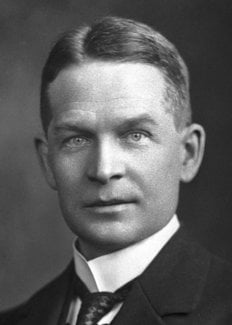Frederick Soddy
Biographical
 Frederick Soddy, the son of Benjamin Soddy, a London merchant, was born at Eastbourne, Sussex, England, on September 2, 1877. He was educated at Eastbourne College and the University College of Wales, Aberystwyth.
Frederick Soddy, the son of Benjamin Soddy, a London merchant, was born at Eastbourne, Sussex, England, on September 2, 1877. He was educated at Eastbourne College and the University College of Wales, Aberystwyth.
In 1895 he obtained a scholarship at Merton College, Oxford, from which University he graduated in 1898 with first class honours in chemistry. After two years of research at Oxford he went to Canada and from 1900 to 1902 was Demonstrator in the Chemistry Department of McGill University, Montreal. Here he worked with Professor Sir Ernest Rutherford on problems of radioactivity. Together they published a series of papers on radioactivity and concluded that it was a phenomenon involving atomic disintegration with the formation of new kinds of matter. They also investigated the gaseous emanation of radium.
Leaving Canada, Soddy then worked with Sir William Ramsay at University College, London where he continued the study of radium emanation. Here, Soddy and Ramsay were able to demonstrate, by spectroscopic means, that the element helium was produced in the radioactive decay of a sample of radium bromide and that helium was evolved in the decay of emanation.
From 1904 to 1914 Soddy was lecturer in physical chemistry and radioactivity in the University of Glasgow. Here he did much practical chemical work on radioactive materials. During this period he evolved the so-called “Displacement Law”, namely that emission of an alpha-particle from an element causes that element to move back two places in the Periodic Table. His peak was reached in 1913 with his formulation of the concept of isotopes, which stated that certain elements exist in two or more forms which have different atomic weights but which are indistinguishable chemically.
In 1914 he was appointed Professor of Chemistry at the University of Aberdeen, but plans for research were hampered by the war. In 1919 he became Dr. Lees Professor of Chemistry at Oxford University, a post he held until 1937 when he retired, on the death of his wife.
After his period at Glasgow he did no further work in radioactivity. His interest changed to economic, social and political theories which gained no general acceptance at the time, and to unusual mathematical and mechanical problems.
His books include Radioactivity (1904), The Interpretation of Radium (1909), The Chemistry of the Radioactive Elements (1912-1914), Matter and Energy (1912), Science and Life (1920), The Interpretation of the Atom (1932), The Story of Atomic Energy (1949), and Atomic Transmutation (1953).
Soddy was elected a Fellow of the Royal Society in 1910 and Oxford awarded him an honorary degree. He was awarded the Albert Medal in 1951.
He was a man of strong principles and obstinate views, friendly with students and prickly with colleagues.
ln 1908, he married Winifred Beilby. He died on September 22, 1956 at Brighton.
This autobiography/biography was written at the time of the award and first published in the book series Les Prix Nobel. It was later edited and republished in Nobel Lectures. To cite this document, always state the source as shown above.
Nobel Prizes and laureates
Six prizes were awarded for achievements that have conferred the greatest benefit to humankind. The 12 laureates' work and discoveries range from proteins' structures and machine learning to fighting for a world free of nuclear weapons.
See them all presented here.
